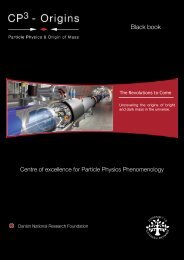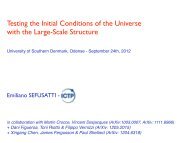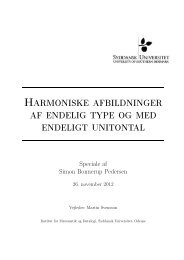Discovering Technicolor: Final Report for LHC School ... - CP3-Origins
Discovering Technicolor: Final Report for LHC School ... - CP3-Origins
Discovering Technicolor: Final Report for LHC School ... - CP3-Origins
You also want an ePaper? Increase the reach of your titles
YUMPU automatically turns print PDFs into web optimized ePapers that Google loves.
11<br />
1000<br />
1000<br />
Number,of,events20,GeV10,fb 1<br />
100<br />
10<br />
1<br />
0.1<br />
Number,of,events20,GeV10,fb 1<br />
100<br />
10<br />
1<br />
0.01<br />
0.1<br />
400 600 800 1000 1200 1400 1600<br />
400 600 800 1000 1200 1400 1600<br />
M llGeV<br />
M llGeV<br />
FIG. 5: left: Dilepton invariant mass distribution M ll <strong>for</strong> ˜g = 2(left), 3(right) and M A =<br />
0.5, 1, 1.5 TeV: our results<br />
C fields and the coupling between the SM fermions and the R bosons are thus dependent<br />
on the ratio between g and ˜g<br />
g R1,2 f ¯f ∼ g˜g<br />
From this we see that the coupling to the SM model is supressed as ˜g increases.<br />
Lepton pair production at <strong>LHC</strong><br />
For our project we used MadGraph to simulate events of the type p¯p → R1,2 0 → l + l −<br />
with l ∈ {e, µ} at <strong>LHC</strong> with √ s = 7 TeV and integrated luminosity of 10 fb −1 <strong>for</strong><br />
two different values of ˜g = 2, 3 and M A = 0.5, 1, 1.5 TeV with the other fundamental<br />
parameters chosen as in [1, chap.4 ]and compared it to the SM background wich we<br />
assumed to be due to p¯p → γ, Z → l + l − . We required that the leptons had p T > 15 GeV<br />
and |η| < 2.5 and divided the work into three different groups each generating 50000<br />
events <strong>for</strong> the different values of M A . We then plotted the invariant mass distribution<br />
of the two leptons <strong>for</strong> the combined events and compared it against the standard model<br />
background. The results are given in Figures 5 and 6 where we see that our results are in<br />
good agreement with the ones obtained in [1]. In Table I we show the masses and cross<br />
sections <strong>for</strong> the R resonances together with the integrated luminosity needed <strong>for</strong> 3 and<br />
5σ detection. From the table we see that MWT <strong>for</strong> our choices of parameters is likely to<br />
be detected or ruled out by <strong>LHC</strong>, which is expected to reach L = 10 fb −1 by 2012.








